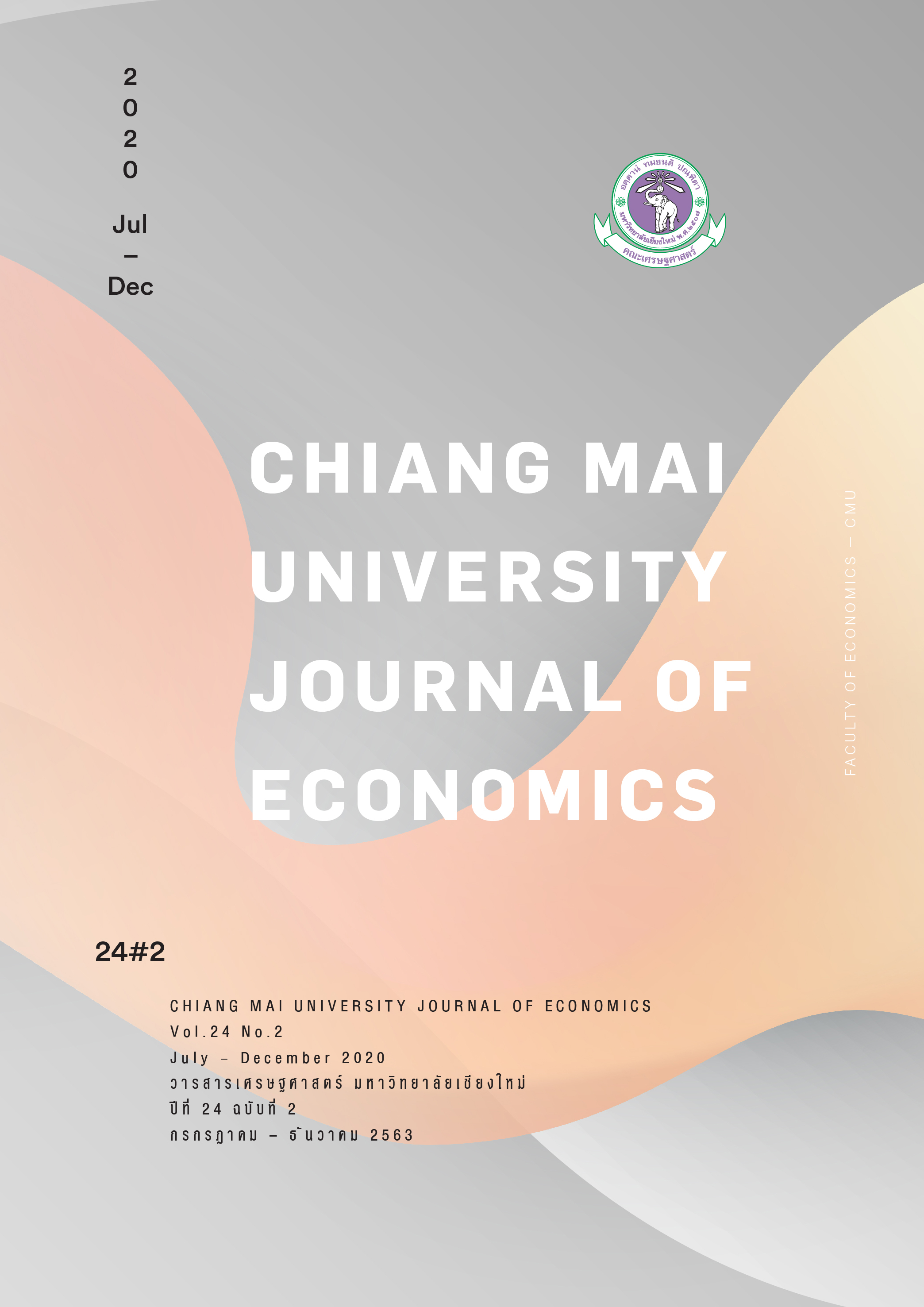Optimal Public Debt Level under Fiscal Sustainability Framework
Keywords:
Fiscal Space, Public Debt to GDP Ratio, The Optimal Public Debt level.Abstract
This paper aims to estimate the optimal public debt to GDP ratio in Thailand using the concept of “fiscal space.” The fiscal reaction function curve and growth-adjusted interest payment curve are estimated with the use of time series quarterly data from 1998 to 2017. The regression results conclude that the relationship between primary balance to GDP ratio and lagged public debt to GDP ratio is a cubic function, enabling the government to increase expenditure, economic activities, and tax revenue. The optimal public debt ratio to GDP is 42%, the debt limit 44% and fiscal space of Thailand is 2.92%. The optimal public debt level and debt limit are controlled under a suitable fiscal sustainability framework.
References
2. Asava-vallobh, N. (2013). Analysis of Fiscal Sustainability under a concept of Fiscal Space. Available online: http://www.fpo.go.th/eresearch/getattachment/50bd4da9-3f87-416d-8e6e-d963050b681f/7669.aspx. (accessed on 8 July 2019). (in Thai)
3. Asava-vallobh, N. (2014). Analysis of Fiscal Sustainability under a concept of Fiscal Space. NIDA Economic Review 2 (8): 70-99. (in Thai)
4. Bastos, F., & Pineda, E. (2013). Fiscal Space of Brazilian. Inter-American Development Bank No. IDB-DP-310.
5. Bohn, H. (1998) The behavior of U.S. public debt and deficits. Quarterly journal of economics 113(3): 949 -963.
6. Bohn, H. (2008) The sustainability of fiscal policy in the United States. In Neck’ R. & Stum, J. (Eds.), Sustainability of public debt. MA : MIT Press.
7. Cancer, M., Grennes, T., & Koehier-Geib, F. (2010). Finding the Tipping Point : When Sovereign Debt Turns Bad. Sovereign Debt and the Financial Crisis (October) Washington DC : World Bank.
8. Cooley, F. T., & Prescott, C. E. (1995). Economic growth and business cycles. Cooley, T., F., editor, Frontiers of Business Cycle Research, chapter 1 Princeton University Press, Princeton.
9. Culling, J. (2017). Debt Sustainability, Fiscal Space, and Growth. Department of Economics, University of Otago, New Zealand.
10. Fall, F., & Fournier, J. (2015). Macroeconomic Uncertainties, Prudent Targets and Fiscal Rules. OECD Economics Department Working Papers 1230, OECD Publishing.
11. Fattah, E. R. (2016). The Impact of Fiscal Space on Economic Growth in Egypt. Helwan University 7(10): 165-171.
12. Fiscal Policy Research Institute Foundation. (2015). Monitoring and evaluation of government project.
13. Fiscal Policy Office. (2007). Meaning of Fiscal Sustainability Framework. Available online: http://www2.fpo.go.th/FPO/index2.php?mod=Content&file=contentview&contentID=CNT0002959&categoryID=CAT0000146 (accessed on 8 July 2019).
14. Ghosh, R. A., Kim, I. J., Mendoza, G. E., Ostry, D. J., & Qureshi, S M. (2011) Fiscal Fatigue Fiscal Space and Debt Sustainability in Advanced Economies. NBER working paper series 1672 123: 4-30.
15. Ghosh, R. A., Kim, I. J., Mendoza, G. E., Ostry, D. J., & Qureshi, S. M. (2013) Fiscal Fatigue Fiscal Space and Debt Sustainability in Advanced Economies. The Economic Journal 123: Available online: https://www.sas.upenn.edu/~egme/pp/w16782.pdf (accessed on 11 July 2017).
16. Hodric, J. R., & Prescott, C. E. (1980) Postwar U.S. Business Cycles : an Empirical Investigation, Discussion Paper no.451, Carnegie Mellon University. This paper was printed in an updated version as : Postwar U.S. Business Cycles : an Empirical Investigation.’, Journal of Money, Credit and Banking, 1997 29(1): 1-16.
17. Hodric, J. R., & Prescott, C. E. (1997). Postwar Business Cycles : An Empirical Investigation. Journal of Money, Credit and Banking 29: 1-16.
18. International Monetary Fund. (2010). From Stimulus to Consolidation : Revenue and Expenditure Policies in Advanced and Emerging Economies. International Monetary Policy Fiscal Affairs Department (April). (Washington).
19. Kydland, E. F., & Prescott, C. E. (1990). Business Cycles : Real Facts and a Monetary Myth. Federal Reserve Bank of Minneapolis Quarterly Review 14: 3-18.
20. Office of the National Economic and Social Development Board. (2019). Data of gross domestic product. Available online: http://www.nesdb.go.th/main.php?filename=QGDP_report. (accessed on 11 April 2019).
21. Mendoza, G. E., & Ostry, D. J. (2008). International Evidence on Fiscal Solvency : Is Fiscal Policy ‘Responsible?. Journal of Monetary Economics 55(6): 1081-1093.
22. Ministry of Commerce. (2019) Datat of Export and Import. Available online: http://www.ops3.moc.go.th/thtrade/ (accessed on 20 March 2017).
23. Ostry, D. J., Ghosh, R. A., Kim, I. J., & Qureshi, M. (2010). Fiscal Space. International Monetary Fund Staff Position Note, SPN/10/11.
24. Polasek, W. (2011). The Hodrick-Prescott (HP) filter as a Bayesian regression model. University of Porto, Oct 25, 2011.
25. Prescatori, A., Sandri, D., & Simon, J. (2014) Debt and Growth : Is There a Magic Threshold? International Monetary Fund Working Paper 14/34. Washington, DC :IMF.
26. Public Debt Management Office. (2017). Public debt Management Act. Available online: http://www.pdmo.go.th/pdmomedia/documents/2019/Jan/4.%20%E0%B8%9E%E0%B8%A3%E0%B8%9A%20%E0%B8%AB%E0%B8%99%E0%B8%B5%E0%B9%89%202548%20(1-4)%20EN.pdf (accessed on 8 July 2019).
27. Data of Public Debt . (2017). Available online: https://www.pdmo.go.th/th/public-debt/debt-outstanding (accessed on 8 July 2019).
28. Roy, R., & Antoine, H. (2015) Investing in development : The MDGs, Aid and the Sustainable Capital Accumulation. Columbia School of International and Public Affairs Journal 58(2).
29. Schick, A. (2009). Budgeting for Fiscal Space. OECD Journal on Budgeting 2009/2.
30. William, G., & Hay, R. (2005). Fiscal Space and Sustainability from the Perspective of the Health Sector.’, London, Policy Practice. Available online: http://thepolicypractice.com/wp-content/uploads/2014/09/FiscalSpaceHealth.pdf (accessed on 11 July 2019).
31. Zandi, M., Chen, X., & Packard, T. (2011). Fiscal Space. Moody’s Analytics. December 20.
Downloads
Published
Issue
Section
License
All opinions and contents in the CMJE are the responsibility of the author(s). Chiang Mai University Journal of Economics reserves the copyright for all published materials. Papers may not be reproduced in any form without the written permission from Chiang Mai University Journal of Economics.
ข้อคิดเห็นที่ปรากฏและแสดงในเนื้อหาบทความต่างๆในวารสารเศรษฐศาสตร์มหาวิทยาลัยเชียงใหม่ ถือเป็นความเห็นและความรับผิดชอบโดยตรงของผู้เขียนบทความนั้นๆ มิใช่เป็นความเห็นและความรับผิดชอบใดๆของวารสารเศรษฐศาสตร์ มหาวิทยาลัยเชียงใหม่
บทความ เนื้อหา และข้อมูล ฯลฯ ในวารสารเศรษฐศาสตร์มหาวิทยาลัยเชียงใหม่ ถือเป็นลิขสิทธิ์เฉพาะของคณะเศรษฐศาสตร์มหาวิทยาลัยเชียงใหม่ หากบุคคลหรือหน่วยงานใดต้องการนำทั้งหมดหรือส่วนหนึ่งส่วนใดไปเผยแพร่ต่อหรือเพื่อกระทำการใดๆ จะต้องได้รับอนุญาตเป็นลายลักษณ์อักษร จากวารสารเศรษฐศาสตร์ มหาวิทยาลัยเชียงใหม่






